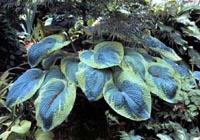Resource Library
Plant of the Week: Hosta, Frances Williams
The University of Arkansas System Division of Agriculture does not promote, support or recommend plants featured in "Plant of the Week." Please consult your local Extension office for plants suitable for your region.
Plant of the Week
Frances Williams Hosta
Latin: Hosta sieboldiana 'Frances Williams'

When I first saw Frances Williams, I had to have her.
After searching for her in various nurseries around my corner of the state, I finally
brought her home, but she wouldn’t stay.
Like most gardeners, I firmly adhere to the rule that, until you have killed a plant
three times, you should never give up. Well, my third Frances Williams finally took
hold and is now flourishing in my garden.
Frances Williams is a large-leafed hosta growing to 18 inches high and 36 inches
across. The heart-shaped leaves grow to the size of a salad plate. They have a greenish-yellow
marginal variegation and are borne on 12-inch long petioles that emerge from the slow
growing crown. The leaf is glaucous with the blade conspicuously corrugated, giving
the plant a quilted look. Whitish bell shaped flowers appear in early summer on leafy
stalks that are just taller than the foliage.
Hostas are members of the lily family.
The plant is named after the hobby breeder who developed it, Frances Williams, who
has 17 hostas to her credit. Frances Williams was registered with the American Hosta
Society in 1986.
It is slow to produce offsets and has tended to be more expensive in the trade than
many of the fast growing sorts. It has been a favorite of hosta growers, ranking fifth
in overall popularity in 1996 among the members of the American Hosta Society.
Of the variegated hostas with yellow margins, Frances Williams is definitely not
the best, but she was one of the earliest of the big-leaf type so she holds a special
place in the hearts of
many gardeners. The main shortcoming of this cultivar is bad parents. As a selection
of H. sieboldiana, she tends to have poor tolerance of summer heat. By August of most
years the foliage that excites even the most jaded gardener in May will begin to develop
marginal burning as the heat of August rolls around. "Wide Brim" with its wide creamy-yellow
margin is not as large but holds up well to the summer heat.
Hostas are creatures of the shade. They perform best in a fertile, reasonably moist
site, but if they are not so lucky as to receive the best planting location, they
usually do very well anyway. Depending on the size of the plant when mature, hostas
should be planted 2 to 3 feet apart. They make excellent groundcovers for shady areas
even though they do die to the ground in the winter.
Variegated selections such as Frances Williams will brighten up the darkest corner
in the shady garden. Hostas respond very favorably to fertilization, but like most
perennials, over doing it will lead to weak growth. I get the best results by fertilizing
in a ring around the plant just as the leaves are emerging in the spring.
Hostas usually should not be divided too often as it takes a few years growth before
plants attain their full size and form. The major pests of hostas are things that
damage their beautiful leaves -- hail stones, slugs and deer being the most common.
By: Gerald Klingaman, retired
Extension Horticulturist - Ornamentals
Extension News - May 7, 1999
The University of Arkansas System Division of Agriculture does not maintain lists of retail outlets where these plants can be purchased. Please check your local nursery or other retail outlets to ask about the availability of these plants for your growing area.